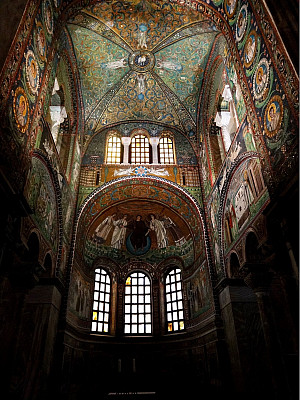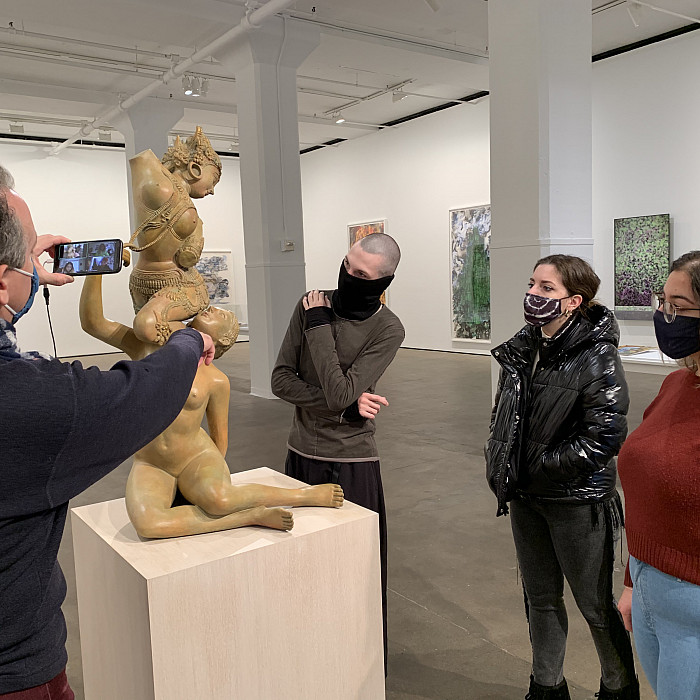Thursday, January 16th, 2014

Interior of San Vitale, Ravenna
Basilica di San Vitale, Mausoleum of Galla Placidia, Sant’Apollinare Nuovo, Sant’Apollinare in Classe
The final dawn of our trip came bright and early in Ravenna, Italy.
Our first stop of the day was a mosaic factory, where we witnessed the making of mosaics in two techniques. One technique involves applying a wet backing to the mosaics and then removing and setting a patch of mosaic in plaster. The other involves applying the tiny mosaic pieces (tesserae), one by one, directly onto the surface of a wall. We watched as two artists performed the techniques in front of us. Our guide also showed us how mosaic pieces come from discs of solid-colored glass, which are made in (where else?) Murano, an island we had visited only a few days earlier.
Basilica di San Vitale and the Mausoleum of Galla Placidia
After witnessing how mosaics were made, we walked over to the sixth-century Basilica di San Vitale, where we saw a great representation of mosaic work. The apse has a magnificent scene of Christ Pantokrator (Christ as Ruler of the World). On either side, on the lower walls, are representations of the great Byzantine ruler Justinian and, on the opposite side, his wife, Theodora. They both wear elaborate crowns and hold instruments of the Eucharist.
Behind the basilica sits an even earlier building, the fifth-century Mausoleum of Galla Placidia. In this small space, mosaics again cover the walls and ceiling. We saw a dramatic scene of Saint Lawrence and, to his left, a cabinet with the four Gospel books. There is also a lovely little still-life scene of a chalice and dove, probably a representation of the Holy Spirit. The tight space meant that we stood and stared at the images, taking in the beauty of each scene.
Sant’Apollinare Nuovo
After a quick lunch, we traveled to Sant’Apollinare Nuovo, also built during the late 5th or early 6th century. The building is very different from the last sites–a much grander space, with a huge apse and even higher ceilings. We soaked in the beauty. The outer walls of the nave are covered in mosaics. On the left are scenes of 24 Virgins and the three Magi in a procession toward the enthroned Virgin and Child surrounded by four angels; on the right is a procession of martyrs leading to an enthroned Christ surrounded by four angels. After witnessing how the mosaics were made earlier that morning, we could really understand how much dedication it took to make all of the complicated mosaic scenes.
Sant’Apollinare in Classe
Our final stop was the sixth-century Sant’Apollinare in Classe, perhaps the most dramatic of all of the Byzantine churches we visited. We took a city bus to get to the site; we found a statue of Apollo out front, which seemed strange, but then learned that the church was built on a pagan burial ground. It reminded us that ancient Greeks lived on this land from the 6th century BCE! The church’s high ceilings and domed structures were overwhelming. We saw the great mosaic in the apse: a scene of Sant’Apollinare, who arrived in Ravenna in the 1st or 2nd century to establish the first Christian community. The main mosaic in the apse showed him in a prayerful position, surrounded by 12 sheep, who represent the 12 Apostles. He is standing in a beautiful, lush garden. Above him is a huge, bejeweled cross and above the cross is a little hand-–the hand of God-–sneaking out from the clouds above. Knowing, again, how this vast mosaic scene was made really put the complexities of the process into perspective.
As the sun set on our final day and as we headed back to the hotel, we were quiet as we contemplated the time spent in Italy. During our (final) evening class, we discussed the readings for the day–Justinian’s law texts, Procopius’ “history” of Justinian and Theodora, and Augustine’s City of God–in concert with the idea of secrets. We thought about how a text and work of art can reveal and conceal at the same time, and how the unseen is often more powerful than the seen.
Conclusion
The time spent in Italy is one we will never forget but as we set off for home tomorrow, the feeling is bittersweet. We look forward to getting back to our day-to-day routine and normalcy of life but, at the same time, we will miss Italy, its calming atmosphere, and beautiful art and architecture that it encompasses.
Published: January 20, 2014
